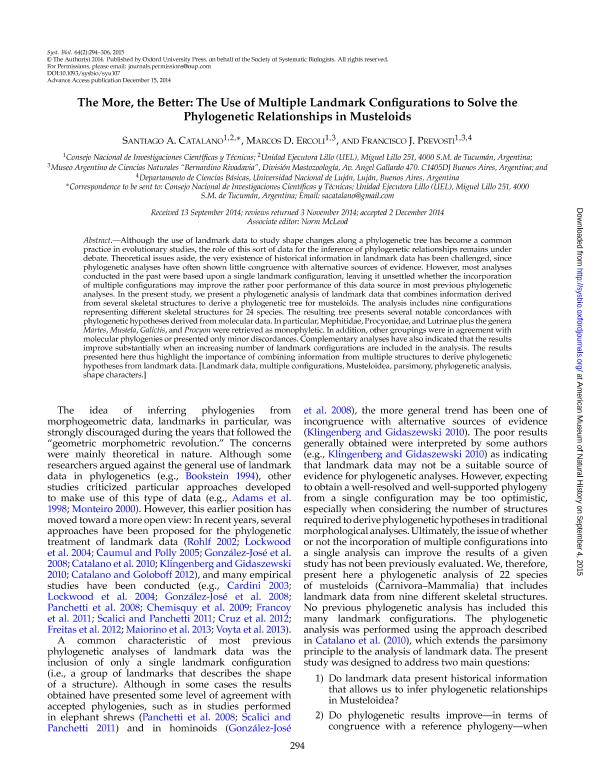Mostrar el registro sencillo del ítem
dc.contributor.author
Catalano, Santiago Andres

dc.contributor.author
Ercoli, Marcos Darío

dc.contributor.author
Prevosti, Francisco Juan

dc.date.available
2018-05-28T21:18:41Z
dc.date.issued
2015-03
dc.identifier.citation
Catalano, Santiago Andres; Ercoli, Marcos Darío; Prevosti, Francisco Juan; The More, the Better: The Use of Multiple Landmark Configurations to Solve the Phylogenetic Relationships in Musteloids; Oxford University Press; Systematic Biology; 64; 2; 3-2015; 294-306
dc.identifier.issn
1063-5157
dc.identifier.uri
http://hdl.handle.net/11336/46364
dc.description.abstract
Although the use of landmark data to study shape changes along a phylogenetic tree has become a common practice in evolutionary studies, the role of this sort of data for the inference of phylogenetic relationships remains under debate. Theoretical issues aside, the very existence of historical information in landmark data has been challenged, since phylogenetic analyses have often shown little congruence with alternative sources of evidence. However, most analyses conducted in the past were based upon a single landmark configuration, leaving it unsettled whether the incorporation of multiple configurations may improve the rather poor performance of this data source in most previous phylogenetic analyses. In the present study, we present a phylogenetic analysis of landmark data that combines information derived from several skeletal structures to derive a phylogenetic tree for musteloids. The analysis includes nine configurations representing different skeletal structures for 24 species. The resulting tree presents several notable concordances with phylogenetic hypotheses derived from molecular data. In particular, Mephitidae, Procyonidae, and Lutrinae plus the genera Martes, Mustela, Galictis, and Procyon were retrieved as monophyletic. In addition, other groupings were in agreement with molecular phylogenies or presented only minor discordances. Complementary analyses have also indicated that the results improve substantially when an increasing number of landmark configurations are included in the analysis. The results presented here thus highlight the importance of combining information from multiple structures to derive phylogenetic hypotheses from landmark data.
dc.format
application/pdf
dc.language.iso
eng
dc.publisher
Oxford University Press

dc.rights
info:eu-repo/semantics/openAccess
dc.rights.uri
https://creativecommons.org/licenses/by-nc-sa/2.5/ar/
dc.subject
Morphometrìa
dc.subject
Filogenia
dc.subject
Musteloidea
dc.subject
Landmark Data
dc.subject
Multiple Configurations
dc.subject
Parsimony
dc.subject
Phylogenetic Analysis
dc.subject
Shape Characters
dc.subject.classification
Otras Ciencias Biológicas

dc.subject.classification
Ciencias Biológicas

dc.subject.classification
CIENCIAS NATURALES Y EXACTAS

dc.title
The More, the Better: The Use of Multiple Landmark Configurations to Solve the Phylogenetic Relationships in Musteloids
dc.type
info:eu-repo/semantics/article
dc.type
info:ar-repo/semantics/artículo
dc.type
info:eu-repo/semantics/publishedVersion
dc.date.updated
2018-05-23T16:31:21Z
dc.identifier.eissn
1076-836X
dc.journal.volume
64
dc.journal.number
2
dc.journal.pagination
294-306
dc.journal.pais
Reino Unido

dc.journal.ciudad
Oxford
dc.description.fil
Fil: Catalano, Santiago Andres. Consejo Nacional de Investigaciones Científicas y Técnicas. Oficina de Coordinación Administrativa Parque Centenario. Museo Argentino de Ciencias Naturales "Bernardino Rivadavia"; Argentina. Consejo Nacional de Investigaciones Científicas y Técnicas. Centro Científico Tecnológico - Tucumán. Unidad Ejecutora Lillo. San Miguel de Tucumán; Argentina. Universidad Nacional de Luján. Departamento de Ciencias Básicas; Argentina
dc.description.fil
Fil: Ercoli, Marcos Darío. Consejo Nacional de Investigaciones Científicas y Técnicas. Oficina de Coordinación Administrativa Parque Centenario. Museo Argentino de Ciencias Naturales ; Argentina. Consejo Nacional de Investigaciones Científicas y Técnicas. Centro Científico Tecnológico - Tucumán. Unidad Ejecutora Lillo. San Miguel de Tucumán; Argentina. Universidad Nacional de Luján. Departamento de Ciencias Básicas; Argentina
dc.description.fil
Fil: Prevosti, Francisco Juan. Consejo Nacional de Investigaciones Científicas y Técnicas. Oficina de Coordinación Administrativa Parque Centenario. Museo Argentino de Ciencias Naturales ; Argentina. Consejo Nacional de Investigaciones Científicas y Técnicas. Centro Científico Tecnológico - Tucumán. Unidad Ejecutora Lillo. San Miguel de Tucumán; Argentina. Universidad Nacional de Luján; Argentina
dc.journal.title
Systematic Biology

dc.relation.alternativeid
info:eu-repo/semantics/altIdentifier/doi/http://doi.org/10.1093/sysbio/syu107
dc.relation.alternativeid
info:eu-repo/semantics/altIdentifier/url/https://academic.oup.com/sysbio/article/64/2/294/1632736
Archivos asociados
